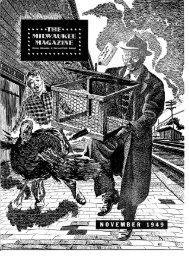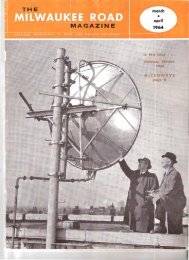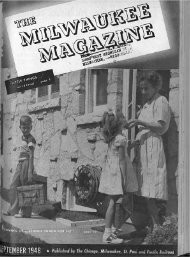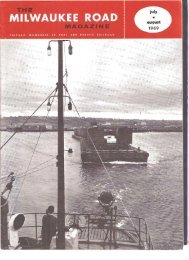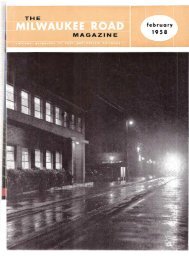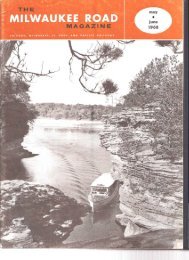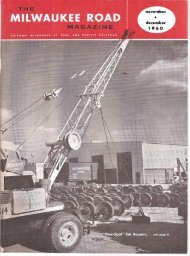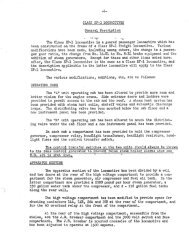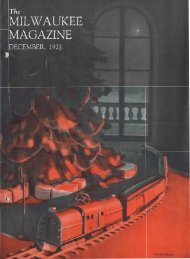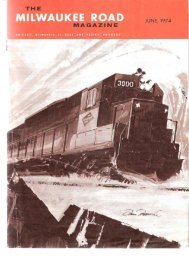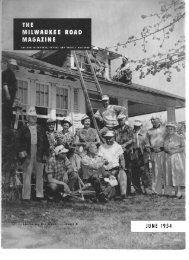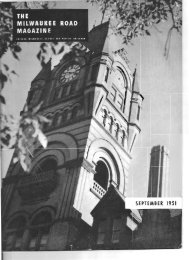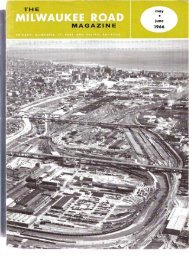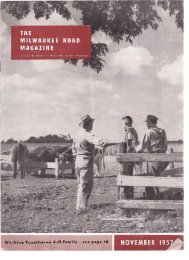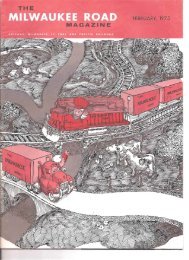March, 1955 - Milwaukee Road Archive
March, 1955 - Milwaukee Road Archive
March, 1955 - Milwaukee Road Archive
Create successful ePaper yourself
Turn your PDF publications into a flip-book with our unique Google optimized e-Paper software.
I·<br />
As shipper Irvin Smith (right) holds a horse steady, Brand Inspector Hilton Hess, brand<br />
book in hand, begins the search for an identifying mark. Every horse must be checked<br />
for the owner's "iron", if any. A "slick" one belongs to the finder.<br />
sorting, weighing and loading. Clutching<br />
his fat brand book, he stationed<br />
himself in one end of the alleyway while<br />
the hands cut out two or three to see if<br />
they were the LBar of Smith, the Lazy<br />
S-Bar of Monk Ward or were "slick".<br />
Every horse in the bunch had to go<br />
through his close scrutiny and if they<br />
carried another brand, the two shippers<br />
had to be ready with bills of sale showing<br />
that the purchase was a legitimate<br />
one.<br />
Some roans were either so honkey<br />
(mad) or spookie (frightened) they<br />
bolted past the guard of cowpokes who<br />
tried to block the alleyway. Once horses<br />
got away, it was up to Tony LaFountain<br />
and his mount, Popcorn, to hustle them<br />
back to the inspector.<br />
"Didn't get kicked or bit," Hess said<br />
later, "but I nearly got run down."<br />
The boys opened gates and shooed<br />
and whistled the inspected horses into<br />
various pens, sorting them according to<br />
type, weight and for saddle possibilities.<br />
Last minute decisions by the owners<br />
saved a few from the glue factory. Some<br />
didn't make the grade, of course. There<br />
was the six;-year old that Vernon Smith<br />
mounted and tested via the barebackand-neck<br />
rein method. Thumbs went<br />
down after a IS-minute trial. Another<br />
big black was whisked off the loading<br />
chute at the last possible moment by the<br />
elder Smith who thought it might make<br />
good riding material.<br />
By afternoon, the weighing process<br />
was in full swing. Three horses were<br />
crowded onto the scales at a time with<br />
Monk Ward or Margie Smith tallying<br />
the total and dividing by three. The<br />
plan was to load an average of 20 horses<br />
to a freight car, although some animals<br />
were so obviously outsize that only 18<br />
could be moved comfortably into that<br />
Flapping his sweaty<br />
·Stetson and shouting<br />
the classic epithet,<br />
one cowboy shoos<br />
four horses from the<br />
pen to the alleyway<br />
where the brand inspector<br />
waits to determine<br />
ownership.<br />
space.<br />
Once 20 were toted, the boys shuttled<br />
them down the narrow alleyway and<br />
opened the chute to the railroad car.<br />
Trouble broke loose as the horses began<br />
to sense they were indeed part of the<br />
last roundup. Dozens of onlookers,<br />
parked on the fences, added their ruckus<br />
to the din sent up by the wranglers<br />
doing the herding on the ground. When<br />
voices failed, butts of ropes and whips<br />
usually made the horses "git in thah".<br />
Side-doors rattled shut and everything<br />
suddenly simmered down to dead silence,<br />
broken only by the curses on the other<br />
side of the corral where horses were<br />
being shunted into a truck.<br />
As the "fence-sitters" began milling<br />
towards town, one grizzled veteran of<br />
many roundups paraphrased Charlie<br />
Russell's pal, Rawhide Rawlins. In 1925<br />
Rawhide told the artist: "I read in the<br />
papers a while back where there's 70,000<br />
wild hosses on the ranges of Montana.<br />
They say these animals are a menace to<br />
stockmen. . . . Mebbe this is right.<br />
"But for thousands of years the hoss<br />
furnished all transportation on land for<br />
man an' broke all the ground for their<br />
farmin'. He has helped build every<br />
railroad in the world. Even now he<br />
builds the roads for the automobile that<br />
has made him nearly useless, an' I'm<br />
here to tell these machine-lovers that it<br />
will take a million years for the gas<br />
wagon to catch up with the hoss in what<br />
he's done for man."<br />
6 The <strong>Milwaukee</strong> <strong>Road</strong> Magazine



